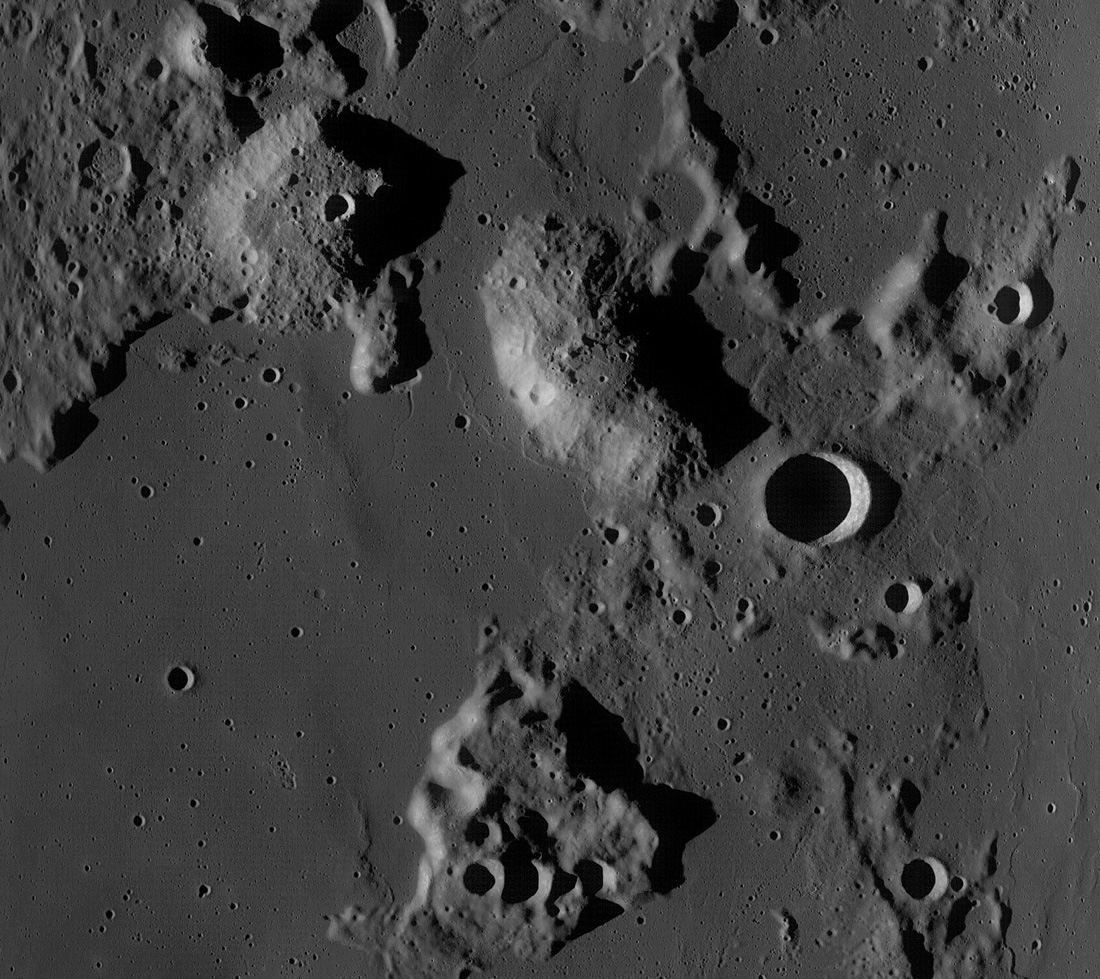Difference between revisions of "September 27, 2010"
| Line 6: | Line 6: | ||
<em>image by [https://the-moon.us/wiki/LROC LRO/WAC] from [mailto:revans_01420@yahoo.com Rick Evans]</em><br /> | <em>image by [https://the-moon.us/wiki/LROC LRO/WAC] from [mailto:revans_01420@yahoo.com Rick Evans]</em><br /> | ||
<br /> | <br /> | ||
| − | This is the bulbous Mons Gruithuisen [https://the-moon.us/wiki/ | + | This is the bulbous Mons Gruithuisen [https://the-moon.us/wiki/Mons_Gruithuisen_Gamma Gamma] and [https://the-moon.us/wiki/Mons_Gruithuisen_Delta Delta] region from LRO Wide Angle Camera. What makes these mountains different to most is that the Gruithuisen Gamma may be a region of volcanic mountain building rather than impact uplift. Also the domes have steeper sides than normal mare domes and those of the [[September_20,_2010|Marius Hills]] The Gruithuisen domes have a unique morphology, and are lighter in albedo, they are bright in the red and infrared-ultraviolet color difference images, which could mean they are composed of thicker low temperature lava high in silicates, rather than high temperature basaltic lava as is usual for low profile mare domes. The more viscous lava flows could have allowed it to build steeper sides as it is thicker and stickier and the flow rates are lower. It is thought that some of the craters on top are vents rather than impact craters. It will be interesting to know with the higher resolution of the WAC that they are still considered such. In Head and McCord (1978) they state that non-mare extrusive volcanism may have continued until 3.3 to 3.6 billion years ago in this region of Oceanus Procellarum. Mons Gruithuisen Gamma is about 1200m high. It will be interesting to see what the [[September_11,_2010|M3 data]] will show for this region.<br /> |
<br /> | <br /> | ||
[mailto:mauricejscollins@hotmail.com Maurice Collins]<br /> | [mailto:mauricejscollins@hotmail.com Maurice Collins]<br /> | ||
| Line 15: | Line 15: | ||
<strong>Related Links</strong><br /> | <strong>Related Links</strong><br /> | ||
Head J. W. and McCord T. B. (1978) Imbrian-age highland volcanism on the Moon: The Gruithuisen and Mairan domes. <em>Science</em>, <strong>199</strong>, [http://www.planetary.brown.edu/pdfs/135.pdf 1433–1436].<br /> | Head J. W. and McCord T. B. (1978) Imbrian-age highland volcanism on the Moon: The Gruithuisen and Mairan domes. <em>Science</em>, <strong>199</strong>, [http://www.planetary.brown.edu/pdfs/135.pdf 1433–1436].<br /> | ||
| − | Rükl plate [https://the-moon.us/wiki/R%C3% | + | Rükl plate [https://the-moon.us/wiki/R%C3%BCkl_9 9]<br /> |
<br /> | <br /> | ||
<p><b>Yesterday's LPOD:</b> [[September 26, 2010|Atlas of Treasure]] </p> | <p><b>Yesterday's LPOD:</b> [[September 26, 2010|Atlas of Treasure]] </p> | ||
Latest revision as of 17:57, 13 October 2018
In the Thick of It

image by LRO/WAC from Rick Evans
This is the bulbous Mons Gruithuisen Gamma and Delta region from LRO Wide Angle Camera. What makes these mountains different to most is that the Gruithuisen Gamma may be a region of volcanic mountain building rather than impact uplift. Also the domes have steeper sides than normal mare domes and those of the Marius Hills The Gruithuisen domes have a unique morphology, and are lighter in albedo, they are bright in the red and infrared-ultraviolet color difference images, which could mean they are composed of thicker low temperature lava high in silicates, rather than high temperature basaltic lava as is usual for low profile mare domes. The more viscous lava flows could have allowed it to build steeper sides as it is thicker and stickier and the flow rates are lower. It is thought that some of the craters on top are vents rather than impact craters. It will be interesting to know with the higher resolution of the WAC that they are still considered such. In Head and McCord (1978) they state that non-mare extrusive volcanism may have continued until 3.3 to 3.6 billion years ago in this region of Oceanus Procellarum. Mons Gruithuisen Gamma is about 1200m high. It will be interesting to see what the M3 data will show for this region.
Maurice Collins
Technical Details
WAC images: M117746175ME M117752970ME M117759764ME Full Image
Related Links
Head J. W. and McCord T. B. (1978) Imbrian-age highland volcanism on the Moon: The Gruithuisen and Mairan domes. Science, 199, 1433–1436.
Rükl plate 9
Yesterday's LPOD: Atlas of Treasure
Tomorrow's LPOD: Moonlit Nights
COMMENTS?
Register, Log in, and join in the comments.



